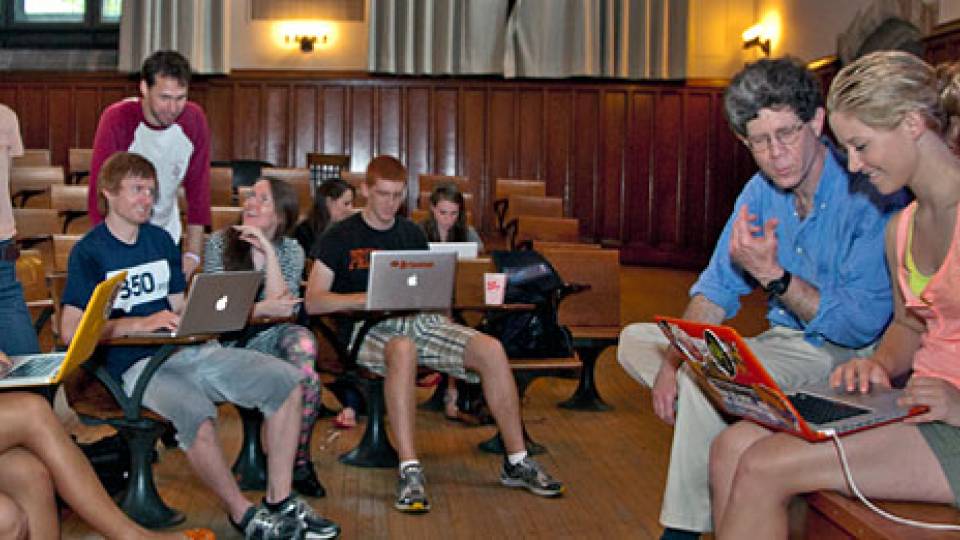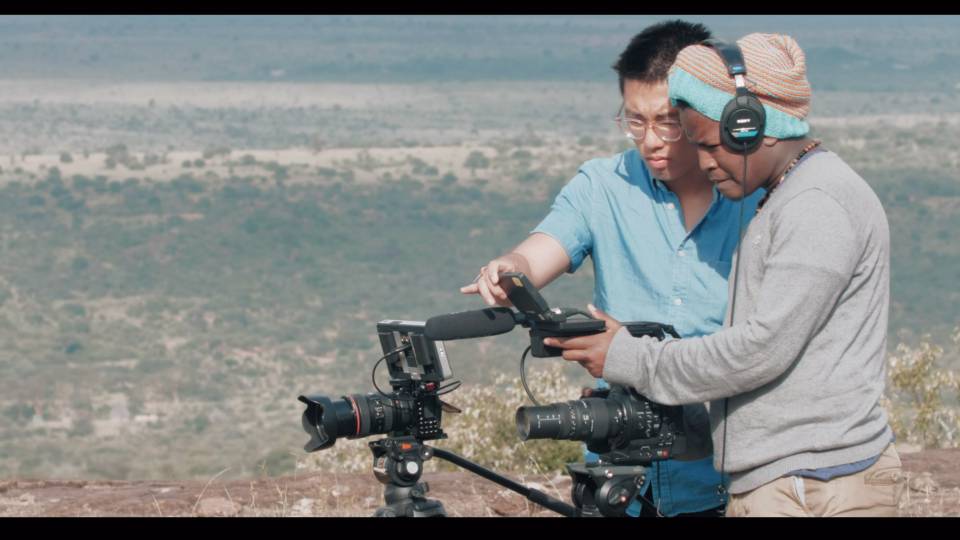Princeton students are learning how diverse storytelling forms can engage with issues surrounding environmentalism and the climate crisis. Pictured: For their final project in “Creative Ecologies: American Environmental Narrative, Media and Art (1980-2020),” one group of students interviewed farmer Jon McConaughy for a podcast, with turkeys on site.
Students in several Princeton courses this fall examined the perils of climate change by considering how storytelling — with elements of description, language and structure — can influence people’s perceptions and fire up the imagination.
One of the classes in the humanities was “Creative Ecologies: American Environmental Narrative, Media and Art (1980-2020),” taught by Allison Carruth, the Fall 2019 Anschutz Distinguished Fellow in American Studies and a visiting associate professor of American studies. Carruth is known for her collaborative work in bridging the arts, humanities and sciences. Read about another fall course focused on the environmental humanities, "Literature and Environment."
“Creative Ecologies” explores how writers and artists, alongside scientists and activists, have shaped American environmental thought from 1980 to today. One of the assignments asked the 12 undergraduates to team up on a storytelling project using various media. One of those teams, highlighted here, created a podcast.
Pen, podcast, paintbrush: The art of constructing stories
One week before Thanksgiving, the 1,500 turkeys at Double Brook Farm in Hopewell, New Jersey, were having a very good day.
As the early morning sun climbed up behind the naked trees, sophomores Abigail Baskind and Bryan To and junior Raneem Mohamed asked Double Brook founder and owner Jon McConaughy about his philosophy of farming.
Carrying a field recorder and notebooks, the students were on a fact-finding tour for their final project — a four-minute podcast-style story. Their story addresses how local food systems can offer a more sustainable future. It includes conversations with McConaughy and Princeton's Dan Rubenstein, the Class of 1877 Professor of Zoology and professor of ecology and evolutionary biology who also directs the Program in Environmental Studies. (Read the transcript.)
The podcast project puts ideas from “Creative Ecologies” into a local context. The class, Carruth said, is an exploration of “how contemporary American writers, artists and media makers take up ideas from the environmental sciences and address pressing environmental challenges.”
In this podcast-style story, the students focus on how local food systems can offer a more sustainable future. Listen to the story. Read the transcript.
As the students navigated around the puddles on the dirt road that led past Double Brook’s heritage pigs, the students learned about McConaughy’s mission.
He explained that he uses a “birth to death” pasture-based farming technique designed to support animal-centered husbandry and local economic and environmental sustainability. Turkeys, chickens, ducks, sheep, pigs and cattle are raised at Double Brook Farm and nearby Thistle Creek Farms. McConaughy made a case for the on-farm slaughterhouse being more responsive to climate change, contrasting it to the global meat industry. “Double Brook aims for a very limited carbon footprint, looking at ways to cut out middlemen while fulfilling our goal of humane animal treatment,” he said.
Meat, eggs and produce are marketed at a Hopewell shop and restaurant owned by the farm and located on the same road. What does not get sold in the market or used in the restaurant returns to the farm as feed or fertilizer.
As the group approached the turkey pen — a bucolic tract of tree-filled land wider than the eye can see — McConaughy said: “Every animal has a story. These are brown and Spanish black heritage turkeys. We hatch the eggs ourselves, we control the bloodline. Our mortality rate is lower. Since they forage themselves, they need no antibiotics and live with no stress of being housed in confinement.”

Students learn about pasture-based farming techniques designed to support economic and environmental sustainability at McConaughy's farm in Hopewell, New Jersey.
McConaughy left a career in finance to start Double Brook with his wife, Robin. As the students exited the turkey pen, giving the farm’s two fluffy white herding dogs, Rufus and Leila, one final pat, Mohamed, a concentrator in civil and environmental engineering, asked: “Why did you leave finance?”
“At the end of the day, there’s nothing you can hold in your hand,” he said. “The measuring stick for success is dollars and cents, and we’re not going to solve the environmental problem that way.”
Associate Professor of English and of Environment and Sustainability at UCLA, Carruth directs an environmental storytelling and science communication lab called LENS that has partnered with media outlets, journalists and artists. This is her fourth visit to Princeton. This past fall, she gave three public talks on topics from rewilding and de-extinction to speculative storytelling.

"Creative Ecologies" is taught by Allison Carruth, the 2019 Anschutz Distinguished Fellow in American Studies and a visiting associate professor of American studies (back left). Students (from left) Abigail Baskind, Class of 2022; Raneem Mohamed, Class of 2021; and Bryan To, Class of 2022, ask McConaughy about how local farming contrasts with global practices.
Discovering ‘a humanistic way to contextualize the science’
In “Creative Ecologies,” students examined a wide range of media, from novels to maps, apps and contemporary art.
“I have always been interested in environmentalism, but I’ve only seen it from a scientific or historical perspective,” said To. “This class allows us to see it through many creative mediums that I’ve never thought about.”
Baskind, a geosciences concentrator who is also earning a certificate in environmental studies, said: “I spend quite a bit of time trying to understand the mechanics of our climate systems. This class offered a humanistic way to contextualize the science and its impacts.”
No stranger to farm life, Baskind took a gap year before coming to Princeton, working on an organic farm near her hometown of Memphis, Tennessee, run by young women. During a summer internship offered by Princeton Environmental Institute, she and a group of students led by Gina Talt in the Office of Sustainability visited area farms to collect crop and soil data for Rubenstein’s course on food and the environment offered the following year.
Carruth said she hopes students will leave the course with “knowledge of the diverse genres and art forms that shape American culture.”
She added, “At the same time, I hope they emerge from the class thinking about themselves as environmental storytellers and communicators.”







